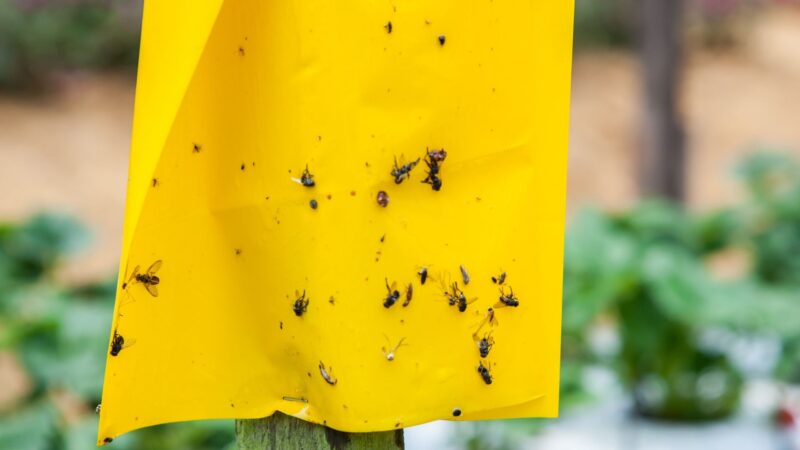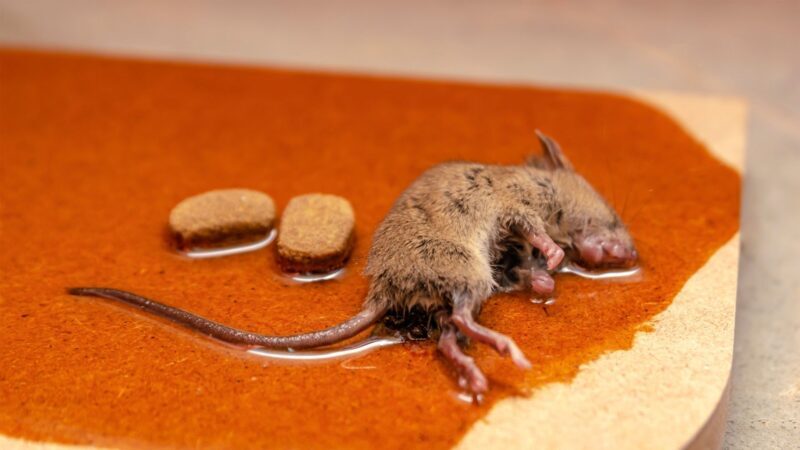Mouse glue traps can accidentally get stuck to hair or skin, especially to children and pets. Removing it may not be that easy, especially if the infected area is severe and can cause wounds.
This is why glue removal from skin or hair should be done with the right methods, correct materials, and extreme patience.
How do you unstick children or pets from a mouse glue trap? First of all, you should calm your child or pet. Then, get a clean and dry towel, cotton swab, and cooking oil or vegetable oil. Gently put some oil on the infected part and clean it gently. Do it repeatedly until the glue is softened, and then remove the glue trap.
Using a glue trap to catch mice is considered inhumane and is not recommended. Aside from that, your child or pet cat (or dog) may unintentionally touch it.
In some cases, you might also remove it incorrectly. To avoid further problems, this article will teach you how to safely remove a glue trap from hair and skin.
Table of Contents
Are Glue Traps Toxic to Pets?

Glue traps are not toxic to pets, but it does not necessarily mean it is safe. The glue itself is not harmful to them but can poison them if they accidentally eat it while trying to escape.
Aside from that, your pet dog or cat can also lose their fur or damage their skin if you remove them from the glue trap in the wrong way.
Are Mouse Glue Traps Harmful to Children?
Mouse glue traps are generally not harmful to children because the adhesive does not contain toxic chemicals. Unlike animals, children are very unlikely to use their mouth to remove the trap from their skin or hair.
However, they might try to remove them. But since the glue is very sticky, they might not succeed.
Can a Mouse Get Off a Glue Trap?

Mouse cannot get off a glue trap, especially if the glue is very sticky and if they are too small to escape. After all, the glue is designed to let mice get stuck until they die.
But in very rare cases, some mice may not be well trapped, or the adhesive used is of poor quality. But still, mice will suffer a lot and will eventually die after escaping.
Do Mice Learn to Avoid Glue Traps?
Some mice have learned to avoid glue traps. According to a study, the glue traps that researchers used had a captured rate of only 8.3% (4 out of 48 glue traps), considering that the glue traps have a peanut oil attractant.
This is far below the 56.2% (54 out of 96) captured rate of their snap mouse traps.
Nevertheless, researchers noted that previous similar studies show satisfactory results of glue traps, but the victims were mostly young mice.
They suggested that adult mice may have already learned how to avoid glue traps or other sticky surfaces, while the young ones were not yet aware of the danger of such traps.
The same study concluded that unfolded glue traps were notably more effective than the folded ones, but the results were still not that high. Mice are attracted to the scent of dead mice on the glue trap and will likely eat them.
But still, they also tend to avoid the strong scent of adhesive or any object that is new to them.
Do Mice Squeak When Dying?
Most mice may squeak while they are dying. In a 2008 study, researchers learned that 11 out of 29 mice (or 37.9%) produced audible sounds after they received tail snips.
The study concluded that some mice may vocalize as their reaction to acute pain, while some mice may not react even if they are hurt.
On the other hand, mice trapped in glue traps will not die at once. But as they try to escape, mice will chew their own fur, skin, and feet. In most cases, mice may also break their limbs.
Therefore, during those very long hours of agony, severe pain, and hunger, it will not be a surprise if they squeak in their dying moments.
How Long Does It Take a Mouse to Die on a Glue Trap?

There is no official study on how long before a mouse will die on a glue trap. But as expected, they will do everything to fight for their dear life.
As the trapped mouse struggles to set itself free, the poor animal will get tired, dehydrated, and die slowly within 3 to 24 hours, depending on how the mouse was trapped.
Is It Illegal to Use Glue Traps for Mice?
According to PETA (People For The Ethical Treatment of Animals), “It’s illegal in the U.S. to use glue traps for most species of animals.” However, there was no mention of the states that ban glue traps for mice.
In fact, the use of mouse glue traps is legal in California via Section 116125 of their Health and Safety Code.
But still, a lot of American companies and stores have announced that they had already stopped using glue traps.
This includes Atlantic City International Airport, Bank of America, and clothing brands such as Banana Republic, Gap, and Old Navy. Meanwhile, glue traps are illegal in Iceland, Ireland, and New Zealand.
Removing Trap Glue From Skin or Hair
As mentioned above, removing trap glue from skin or hair can be challenging. A simple mistake can lead to wounds, especially if infected hair is very close to the skin.
The key here is to try to remove the glue trap very slowly and observe if it is peeling off without creating a wound on the skin. If you are not sure, then stop.
Put a few drops of coconut oil, vegetable oil, baby, mineral oil, or peanut butter on the infected skin or hair. If possible, heat the oil first by dipping the container for a few minutes in hot water.
Then, test it slightly to your wrist before applying it to the infected area. Never use motor oil, kerosene, paint thinner, and other solvents.
How Do I Get My Cat Unstuck From a Sticky Mouse Trap?

Cats and kittens are very curious animals and will tend to investigate anything unfamiliar to them.
If your pet cat got stuck on a mouse glue trap, it will not ask for help from you but will try to remove it herself, which can be very dangerous. So, once you see your cat starting to panic, here are the things you should do:
1. Calm your cat.
Cats or kittens that got stuck on a glue trap are very likely to panic. Try to calm her by carrying or giving her some treats.
But before doing so, wear some protective gloves in case your pet cat gets hysterical and will bite or scratch you. Sometimes, cats may think that your action will cause additional discomfort.
2. Remove your cat out of the glue trap.
Using a pair of scissors, cut the fur that got stuck on the trap but do it gently and slowly, especially if the fur is very close to the cat’s skin.
If you think you cannot do it alone, ask someone who can do it or bring your cat to the veterinarian. If the cat’s paw got stuck, put some oil on it to soften the glue before removing it.
3. Clean the infected area.
After removing your cat from the glue trap, she is likely to lick the infected area. Since the infected area still has some glue residue on it, wrap it with a clean and dry cloth.
Massage the area with cooking oil or olive oil or vegetable oil until the glue is completely gone. Never use paint thinner or any other solvent.
4. Dry your cat.
Sometimes, you may need to rub the infected area repeatedly before you can totally remove the glue. You might also want to use a cat shampoo to further clean your cat.
After rinsing the area and once you are sure that your cat is clean, wipe her gently with a clean and dry towel. Wash your hands afterward.
How Do You Get a Dog Unstuck From a Glue Trap?

The procedures for removing your pet dog from a glue trap are somehow similar to that of your pet cat. But since dogs are bigger and heavier than cats, there should be additional precautionary measures.
This is not only to protect your dog but also yourself. Here are some steps in getting a dog unstuck from a glue trap:
Step 1: Cover your dog’s head.
Using a clean and dry towel, gently cover the head of your dog, especially its snout. This is to prevent him from escaping or trying to stop you or licking the infected area.
You might also want to caress your dog or touch its head for a while before doing anything. This is to assure him that everything will be alright.
Step 2: Remove your dog out of the glue trap.
For bigger dogs, you might need someone that your dogs trust to touch them. In most cases, you should let your dog lie down comfortably.
Regardless of the size of the infected area, you will need cotton swabs with some oil and a razor to shave the infected part. Don’t use motor oil, solvents, or kerosene for your dog.
Step 3: Clean your dog.
Once your dog is removed from the glue trap, clean your dog thoroughly, or better yet, give him a nice, warm bath.
Gently massage the infected area and make sure that not even a very small amount of glue is left on its fur and skin. Check other parts of your dog that might also have some glue, especially his snout.
Step 4: Dry your dog.
Rub the body of your dog with a clean and dry towel. While doing so, double-check the previously infected area for some adhesive residue and other areas that you might have missed earlier.
Don’t offer food or water if you feel that your pet dog is still in shock. Instead, let him rest comfortably until he falls asleep.
How Do You Get Glue Traps Off Kids?
Most kids are curious and are not yet aware of the danger of glue traps. But unlike animals, it is a bit easier to remove glue traps from them because their skin is hairless.
But still, doing it the wrong way can add pain to your child. To help you out, here are some tips on how to get glue traps off your small child:
1. Calm your child.
Your child will tend to scream or cry for help, especially if he feels the pain while trying to remove the glue trap himself.
Try to relax your child by hugging him, singing a song, or simply explaining to him that you will help him and there’s nothing to worry about. Don’t take any action while your child is still crying.
2. Remove the glue trap.
Try to remove the glue trap slowly from your kid’s skin or hair. If the adhesive is too sticky or your child feels some pain, spray some oil or peanut butter on the infected area to soften the glue.
Let it sit for a few minutes and rub it again until you can already remove the glue trap from the skin without hurting your child.
3. Wash the infected area.
Clean the infected area with soap and water or shampoo for hair. Rub it again gently to remove the leftover oil, and repeat the process if necessary.
To make your child feel more comfortable, bathe him and allow him to play for a while to help him get over the trauma. Then, dry your child and let him rest or sleep.
How to Remove Mouse Trap Glue From Carpet?
Removing mouse trap glue from a carpet (or clothes) is a lot easier than doing it on children and pets. However, using glue removal products with strong chemicals may ruin your precious belongings.
To avoid damage, here are some simple tips on how to get a glue trap off our carpet, clothes, or similar items:
- If your carpet gets stuck with a glue trap for only a few seconds, you may try to remove it slowly. But if you cannot remove it, don’t force it.
- Place your carpet in a freezer for a couple of hours until the glue is hardened and easier to remove.
- If your carpet is too big, place an ice pack in the infected area until the glue has dried.
- Once the glue is dry, scrape the glue off the carpet slowly and gently.
- Alternatively, you may use a vinegar solution (3 parts of water, 1 part of white vinegar) to remove the glue residue.
- For liquid-based glue, put a thin cloth on top of the infected area and iron it. The glue should transfer from the carpet to the cloth.
- Before using other solutions, contact the carpet manufacturer and ask for suggestions.
How Do You Dispose of a Live Mouse in a Glue Trap?
Without a doubt, mice are dangerous pests, and we have to get rid of them. But still, we should not let them suffer while dying slowly.
So, if you have a glue trap that caught a mouse that is still alive, don’t just throw it away. Instead, here are some humane options on how to dispose of a live mouse caught in a glue trap.
Option #1: Release the mouse.
- Wear heavy-duty safety gloves.
- Hold the mouse on its head so it won’t escape or bite you.
- You may also cover its head with a rag and hold it.
- Pour vegetable oil or cooking oil on the glue trap where the mouse got stuck.
- Gently remove the mouse out of the trap and place it inside a sealed bag or plastic container.
- Let the mouse rest for a while.
- Choose a location where the mouse will be safe from predators but far away from your property.
- If are in doubt to free the mouse, call a wildlife rehabilitator or a licensed pest exterminator.
Option #2: Kill the mouse using dry ice (or carbon dioxide).
- Get a small container and put some dry ice, which contains concentrated carbon dioxide (CO2). If you don’t have dry ice at home, LIVE 2DAY Nice Packs Dry Ice is one of the cheapest you can buy.
- Wear protective gloves and remove the mouse from the glue trap.
- Place the mouse inside the container, and the mouse will soon die of suffocation.
- For faster results, purchase CO2 canisters such as Goodnature CO2 Canister. Read product labels before using.
Option #3: Kill the mouse with a sharp blow to the head.
- Get a hammer or any hard object that can cause a severe head injury.
- Since the mouse cannot move, aim at its head to have a clear shot.
- Give the mouse a sharp blow to the head, and it will die quickly.
Note: Don’t do this if you cannot take the sight of blood.
Option #4: Kill the mouse with an air pistol
- Make sure you know how to use an air pistol properly and safely.
- Aim to the center of the head so that the mouse will die instantly in just one shot.
How to Make Mouse Trap Glue?
Some glue traps are ineffective and expensive. To help you save some money but still can trap mice, you can make your own rat glue traps. DIY (do-it-yourself) mouse glue traps are very easy to make, and the materials are sometimes available in your home. Here are the steps on how to make glue traps for mice:
Step 1: To make rat glue, put a cup of corn syrup and a cup of water in a pan.
Step 2: Heat the pan on the stove. Mix thoroughly until the mixture gets thick and sticky.
Step 3: Turn off the stove and let the mixture cool.
Step 4: Cut some pieces of cardboard with your desired size. Spread the rat glue on the cardboards evenly.
Step 5: For better results, use Tomcat Glue Traps Mouse Size with Eugenol instead of corn syrup and water. Each pack contains 6 pieces of glue trap of about 3 x 5 inches. Staple (or use duct tape) some of them together on cardboards.
What Can I Use Instead of a Mousetrap?
Glue traps and snap traps can kill mice. But if you want to catch them alive without harming them, you can use bait and trap them in a container.
So, instead of commercial mouse traps, here are some simple ways how to create a trap that can attract mice effectively without killing them:
Bucket Trap
Step 1: Prepare a bucket with sunflower seeds at least 1/4 of the surface level.
Step 2: Put some peanut butter around the interior side of the bucket at the level where mice can hang and drop into the bucket. Put a ramp so that mice can climb to the top of the bucket.
Step 3: Leave the bucket trap near where mice can easily find it.
Bowl Trap
Step 1: Prepare a deep plastic bowl with some peanut oil, slippery enough to prevent mice from escaping.
Step 2: Place a small ramp so that mice can easily climb to the bowl. Leave the bowl trap near their hiding place.
Summary
Again, mouse glue traps are not only a form of cruelty to mice but can also scare children and animals. If you still want to use them, keep them away from your child and pets.
But as much as possible, use other methods to get rid of mice. Better yet, think of ways to prevent mice from entering your house.
List of Sources
The Efficacy of Glue Traps Against Wild Populations of House Mice, Mus Domesticus, Rutty
Ultrasonic Sound as an Indicator of Acute Pain in Laboratory Mice